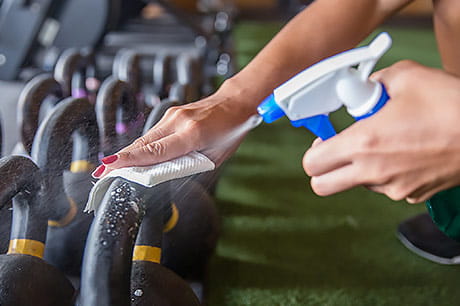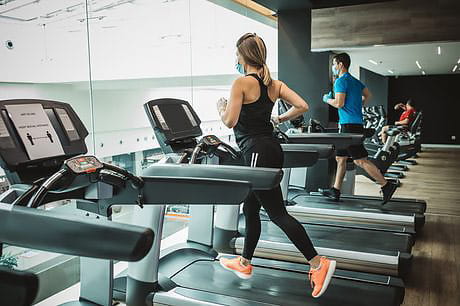5 tips for returning to the gym
Getting back to the gym after months of being closed is exciting. Here’s how to do it safely.
by Roxanna Larsen, director of sports medicine, orthotics and fitness at Geisinger Woodbine Lane
Whether you’re an avid, competitive athlete or a calm, cool, collected yogi, you might be getting ready to head back to your gym or fitness studio. But with the novel coronavirus still active, it’s important to practice safety precautions when you step back into a fitness routine outside your home.
These tips will help keep you protected when you return to your gym, box or yoga studio.
1. Don’t jump back into exercising too quickly
If it’s been awhile since you’ve last exercised to your full potential, your body may not be ready to jump in where you left off. Instead, start slow and build yourself back up to your previous fitness level.
Remember to stretch — it’s a great way to lengthen and help tone your muscles. Stretching before and after exercising will also help you prevent injuries.
You also want to work to build up your endurance again, whether it be starting with lighter weights than you used to use or running intervals instead of 45 minutes straight.
2. Practice social distancing at the gym
Keeping 6 feet of distance between you and your fellow gym-goers is key. Your gym should refrain from allowing patrons to use cardio equipment that’s close together, and you’ll need to be mindful of how close you are to others when you hit the weights.
If you’re attending group fitness classes, check to see that your gym or studio is limiting the number of people allowed in each class. This helps make sure there’s enough room to practice social distancing within the classroom.
You might even consider wearing a cloth, breathable face mask when you exercise at the gym, too, which can help minimize your exposure to viruses.
3. Disinfect the equipment
Before COVID-19, it was common for fitness centers to include paper towels and disinfectant spray throughout the facility. Make sure you’re using these after you’re done with each piece of equipment and consider wiping down the weights or machine before using them also. This will help protect yourself and anyone who uses the equipment after you.
Ask your local gym about what it’s doing to disinfect the space and equipment, too. Make sure staff are taking the necessary steps to protect your health by thoroughly cleaning their facilities regularly and following appropriate safety measures.

Pro tip: When you spray-clean equipment, let it sit a minute before wiping. Then, let it dry completely before use. This gives the disinfectant time to kill any germs that may be on the bench, weights or cardio equipment.
4. Don’t touch your face
Throughout your workout and time at the gym, avoid touching your face. This might be harder than normal if you’re sweating, so keep a clean towel (or two) nearby or over your shoulder while you exercise. Then, when you need to wipe the sweat away, you can do so without touching your face.
Skip the latex gloves when you’re at the gym, too. If you’re worried about handling weights, you can use a paper towel as a barrier or wipe them down before you use them. But remember — COVID-19 is primarily transmitted if you touch your face (eyes, mouth or nose), transmitting the virus from your hands, or from direct person-to-person contact from someone close who is carrying the virus. So, if you avoid touching your face and keep your distance for other gym-goers, you’ll lessen your chances of getting sick.
When you’re done at the gym or studio, give your hands a good scrub with soap and water. Remember, it takes 20 seconds of vigorous hand washing with warm water to remove dirt, bacteria and viruses that can make you sick.
Keeping some hand sanitizer or disinfecting wipes handy in your car or gym bag is also a good idea.
5. Stay home if you aren’t feeling well
If you’re coughing, have an upset stomach, runny nose or fever — or aren’t feeling well in general — skip the gym. This will help your body recover fully while also keeping others from getting sick. Plus, it’s a good habit we can all practice moving forward to help limit the spread of viruses in general.
If you’re still feeling like you need some kind of movement, consider taking a walk around your neighborhood or doing some yoga at home instead.
Not sure what’s best for you? Talk with your doctor about when it’s safe for you to head back to the gym. Depending on your overall health or any underlying health concerns, they can help you best prepare for getting back to a fitness routine or suggest alternates until it’s safe for you to hit the gym again.
Next steps:
Make an orthopaedic appointment at Geisinger Woodbine Lane
Not ready to hit the gym? These at-home workouts have you covered.
Here are some low-impact exercises to help you get in shape

Telemedicine video visits
See your doctor from the comfort of home — from routine care to specialty care
Get virtual care nowCOVID-19 updates: Visit Geisinger's Coronavirus Resource Center for the latest information and helpful resources.
